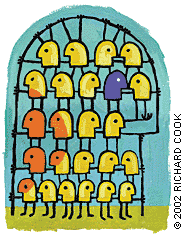
Never underestimate the effect common courtesies can have on your patients, your staff and your life.
Fam Pract Manag. 2002;9(4):70

Traveling around the country shortly after Sept. 11, I frequently heard people remark, with great surprise in their voices, “Everyone is being so nice!” Why was this display of common courtesy so shocking? For one, we had just witnessed a complete lack of civility in the terrorist attacks that senselessly took so many lives. But we were also shocked because common courtesy isn’t that common anymore.
Here are five ways to make courtesy and respect more common in your professional life.
1. Get back to basics
“Please,” “thank you” and “I’m sorry” are always appreciated. When Ford Motor Company found defective tires on its most popular sports utility vehicle several years ago, the CEO didn’t apologize but spent billions of dollars replacing the faulty tires for free. Around the same time, the CEO of United Airlines publicly apologized for his airline’s inability to get passengers to their destinations on time, but he did not offer a single frequent flyer mile in compensation. Which CEO fared better in an informal poll? There was no contest. United’s CEO, Jerry Greenwald, was the winner. And, according to respondents, it was for a very simple reason: He said he was sorry.
When was the last time you apologized to a patient for waiting or thanked a patient for his or her visit? Research suggests that a physician’s apology can even help prevent a lawsuit.1 I consider that a powerful indicator of just how much importance we still place on old-fashioned values.
2. Be courteous to your staff
Do unto your staff as you would have them do unto your patients. They’ll be more satisfied as employees and learn from your example. If you don’t already, begin greeting them in the morning with an interested and warm “hello.” Thank them at the end of the day when they go beyond the call of duty. These simple courtesies are unfortunately the exception rather than the rule in today’s world, but that makes using them extraordinary.
3. Create a positive first impression for patients
Some companies now refer to their receptionist as the “concierge” or “director of first impressions.” Sure it sounds silly, but it’s a good reminder not to underestimate what warmth and kindness can do for your patients. A smile or an unhurried word from your front-office staff can in many ways be as healing as the medication you prescribe. If you really want your practice to shine in the eyes of your patients, don’t tolerate poor people skills from your front-office staff, no matter how capable they may be at other aspects of their jobs.
4. See problems as opportunities
Long waits are a problem in most practices, and sometimes they simply can’t be avoided. If, despite your best efforts, a patient must endure a long wait, why not use it as an opportunity to show courtesy and respect instead of quietly hoping he or she won’t notice the wait or won’t say anything about it. For example, you could hand out coupons from local retailers as an apology to patients who have had to wait too long. Or sometimes a simple acknowledgement from a staff member may be all that’s needed.
5. Set standards
Small gestures of courtesy can have quite an impact, especially when they occur with consistency. Develop practice-wide guidelines for treating patients courteously and get your entire staff involved. [For more information, see “Building a Mind-Set of Service Excellence” on page 41]. And remember, opportunities exist to show patients respect and courtesy outside the office as well, for example, by following up with a phone call after an important visit.
Exceeding expectations
Some patients today enter their doctor’s office expecting a long wait, a hurried response or a sigh from a staff member who just doesn’t want to be bothered with one more question. Instead, why not surprise your patients with a kind word or a polite gesture? It doesn’t cost a penny and both you and your patients will benefit.